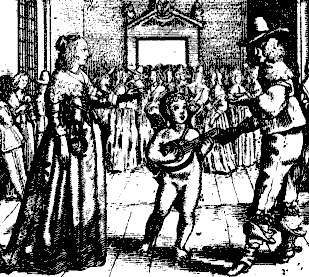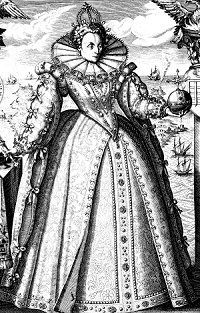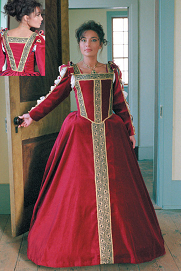
On Wednesday, November 10th you will be participating in a class project involving Shakespeare and Renaissance Dance. This will explore "The Given Circumstances" as you become an actor as sleuth to discover as much as possible from your script in order to prepare for a performance. Taking a look at your syllabus, it also points out that a skill you will develop in class is your sense of Identification: an ability to enter fully into an imagined world. In Wednesday's class, you will enter into a world which existed over four-hundred years ago, a time of Shakespeare and Renaissance Dance.
You are asked to dress in comfortable clothing which allow movement, as well as appropriate footwear. You may feel more comfortable wearing indoor shoes or even slippers. It is your choice, but not required. We will also be meeting in the Movement room instead of our regular studio; the time remains the same.
Please ensure you have reviewed the following prior to class, they will assist in building and living in our imagined Renaissance world.
Renaissance dance is refers to the earliest European dances which can be reconstructed with any confidence. Knowledge of Renaissance choreography comes largely from the surviving notes and treatises of dance masters and students which span two centuries. Thus, a wide variety of styles are covered by this term. (Therefore, Elizabethan and Baroque style can be classified under the Renaissance title)
The style that emerged in France in the early 1600s marks the beginning of what is usually called Baroque dance. This is generally considered the endpoint of Renaissance dance. The starting point is the earliest extant choreographic work: De Arte Saltandi & Choreas Ducendi by Domenico da Piacenza, from the middle of the 15th century. Domenico's court dances include the first choreographies that could be considered ballets. The community-oriented French branles of the late 16th century are most likely decendants of Medieval folk dances. Dances such as the saltarello, galliard, and coranto were improvised forms popular amongst most European countries and classes.

In the mid-1500's, sumptuary laws were decreed that commoners should wear clothing of only one color. To get around this new unpopular law, both men and women began slashing their clothes; cutting open the outer surfaces of their garments (doublets, sleeves, hose) to expose the contrasting color of the linings beneath. These linings would then be pulled through the cuts and puffed out to further emphasize the contrast. At first these slashings consisted of small, intricate patterns, but from 1600 to about 1650, slashings were longer and vertical in shape.

Men's hats were broad, and some were trimmed with gems. Women's robes were expanding below the waistline: by 1550 hoops made of wire or wicker, held together with ribbons and tapes, were used for support.
From about 1550 to 1600 the Renaissance was dominated by Spanish fashions. The clothing worn during this period were influenced more by geometric shapes than by the contours of the body. The human form was considered as two basic platforms--hips and shoulders. While clothing was constructed to fit the wearer, on the outside it was padded and shaped to show a completely different form. Dark silks and velvets were the most popular fabrics. During this period a person's wealth was gauged by the value of the gems sewn onto his clothing. In men's dress the short gown was replaced by a short cloak. The cloak was worn with trunk hose, or short breeches, padded with horsehair. Knitted stockings were developed at this time, and their close adherence to the legs contrasted with the padded body.
The Renaissance (and Elizabethan era in particular) was a highly fashion-conscious age; a look that is elaborate, artificial, stylized, and striking. Men and women alike were concerned to be wearing the latest and most fashionable outfits, and although the most fashionable clothes are worn primarily by the upper classes, their fashions influence ordinary people as well.
Clothing at this time created an impression of mass and bulk. The costume was appropriate for people who see themselves as indomitable. Clothing during the reign of Elizabeth (1558-1603) always reflected the social status of the wearer. There would be no doubt in ones mind about picking out the nobility in any given crowd. Clothing is a direct indication of wealth. The cost of clothing is related to the type of fabric and the color. Purple dye is extracted by crushing thousands of tiny sea snails; similarly, crimson dye is obtained by crushing a certain type of ant. Processed fabrics such as velvet or corduroy are costly, as are satins and other fine weaves. Cotton, wool, and flax are common.


The hoopskirt, or farthingale (seen above), reached its maximum width around 1600, when it assumed a cartwheel or drum-shaped appearance. Combined with ballooned sleeves and expanded ruffs or circular lace collars, it made a woman appear formidable or even unapproachable. With puffed-out trunk hose, balloon sleeves, padded doublets, and the same large ruff collars, men achieved a similar appearance.

Shakespeare was first recognized as an actor, poet, and playwright in 1589, when a rival playwright, Robert Greene, referred to him as "an upstart crow" in "A Groatsworth of Wit." A few years later he joined one of the most successful acting troupes in London: The Lord Chamberlain's Men. When, in 1599, the troupe lost the lease of the theatre where they performed (appropriately called The Theatre), they were wealthy enough to build their own theatre which they called The Globe. The new theatre opened in July of 1599, built from the timbers of The Theatre, with the motto "Totus mundus agit histrionem" (A whole world of players). When James I came to the throne (1603) the troupe was designated by the new king as the "King's Men" (or "King's Company"). The Letters Patent of the company specifically charged Shakespeare and eight others "freely to use and exercise the art and faculty of playing Comedies, Tragedies, Histories, Interludes, Morals, Pastorals, stage plays ... as well for recreation of our loving subjects as for our solace and pleasure."
Shakespeare entertained the King and the people for another ten years until June 19, 1613, when a canon fired from the roof of the theatre for a gala performance of Henry VIII set fire to the thatch roof and burned the theatre to the ground. The audience ignored the smoke from the roof at first, being to absorbed in the play, until the flames caught the walls and the fabric of the curtains. Amazingly there were no casualties, and the next spring the company had the theatre "new builded in a far fairer manner than before." Although Shakespeare invested in the rebuilding, he retired from the stage to the Great House of New Place in Statford that he had purchased in 1597, and some considerable land holdings, where he continued to write until his death in 1616 on the day (or so it is is reported!) of his 52nd birthday.